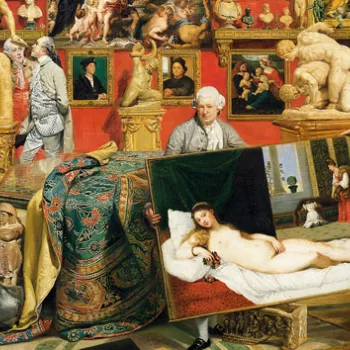Frederick, Prince of Wales, with the Members of the 'La Table Ronde' Signed and dated 1732
Oil on canvas | 127.6 x 102.3 cm (support, canvas/panel/stretcher external) | RCIN 406101
-
This is one of two paintings in the Royal Collection, both now ascribed to Philips and both acquired by George IV, which document the existence of clubs of which there is no other surviving record (OM 533, 406101 and OM 535, 405737). This painting was described in a Carlton House inventory of 1816 as ‘The late Prince of Wales, with the members of ‘La Table Ronde’. On 21 May 1813 George IV’s agent recorded the receipt of the other painting (OM 535) ‘Consisting if Seven Portraits’ from one General Wilkes, adding that ‘Frederick Prince of Wales Established a Club — Called the Gang or Harry The Fifth’s Club — the members of which were Call’d Fallstaffs Points — Bardolph &c’.
In so far as it is possible to characterise a club from its name, both of those recorded in Philips’s paintings appear to be versions of ‘Liberty Hall’. In The Henry the Fifth Club or ‘The Gang’ Frederick casts himself as a previous Prince of Wales, the mad-cap Prince Hal, with his disreputable boon companions before becoming the legendary hero-king Henry V, leading another ‘band of brothers’ to victory. In this painting Frederick is depicted as King Arthur meeting on terms of equality with his Knights of the Round Table. He sits centrally, under some imposing voussoirs and a carved version of the Prince of Wales feathers, but not at the head of a table which can have no head; no servants are seen because the knights serves each other as the punchbowl circulates; none wears a hat. Even the inscriptions — ‘Interruption’ written under the man in the centre foreground who has overturned his chair and spilt his wine, ‘Orders and Constitution’ on the paper held by the man next to him — suggests the jocular-solemnity of club democracy. In both these cases the idea expressed is best summed up in the description by engraver George Bickham (c.1706-71) of a temple in the Gardens of Stowe dedicated to Frederick Prince of Wales’s political associates, the Patriots, in which he concludes ‘Friendship has no monarchs’ (The Beauties of Stow, 1750).
The hunting uniform worn here, complete with boots and spurs, was designed by Frederick and seems to have caught on: a royal page described it in 1729, as ‘blue, trimmed with gold, and faced and lined with red. The Prince of Wales, Princess Anne, the Duke of Cumberland, Princess Mary, and Princess Louisa wear the same, and looked charming pretty in them. . . a world of gentlemen have had the ambition to follow his Royal Highness’s fashion.’ Such a fashion is an interesting variation on livery - uniform specific to a household and worn only by servants - and seems designed to express allegiance (perhaps reciprocal) rather than service. John Wootton’s hunting scenes in the Royal Collection show the Prince’s uniform worn by him and some of his servants. The same hunting uniform is worn by Princess Anne in the painting over the fireplace (from an original by Mercier). The idea of women sporting such masculine riding gear was not universally approved at this time:
‘The Model of this Amazonian Hunting-habit for Ladies, was, as I take it, first imported from France, and well enough expresses the Gayety of a People who are taught to do any thing so it be with an Assurance; but I cannot help thinking that it fits awkwardly yet on our English Modesty. The Petticoat is a kind of Incumberance upon it; and if the Amazons should think fit to go in this Plunder of our Sex’s Ornaments, they ought to add to their Spoils, and complete their Triumph over us, by wearing the Breeches.’ (Richard Steele, Spectator No 104, 29th June 1711)
This painting is often said to depict the interior of Frederick’s villa, the White House at Kew. The room here is clearly lit by a Venetian Window (that is of straight-arched form), yet no such window occurred at the White House. It is most likely that this is an imaginary hunting lodge, with Doric columns appropriate for such a manly sport, and with every available space for decoration bearing some symbol of the chase: animal skulls and circular hunting horns in the metopes of the frieze, hanging trophies of the hunt between the columns, and more hunting horns in the decoration between the capitals.
Text adapted from The Conversation Piece: Scenes of fashionable life, London, 2009Provenance
Acquired by George IV; recorded in store at Carlton House in 1816 (no 283) and 1819 (no 221); taken to the Grand Corridor at Windsor Castle in 1828
-
Creator(s)
Acquirer(s)
-
Medium and techniques
Oil on canvas
Measurements
127.6 x 102.3 cm (support, canvas/panel/stretcher external)
163.7 x 139.2 x 18.6 cm (frame, external)
Category
Object type(s)









